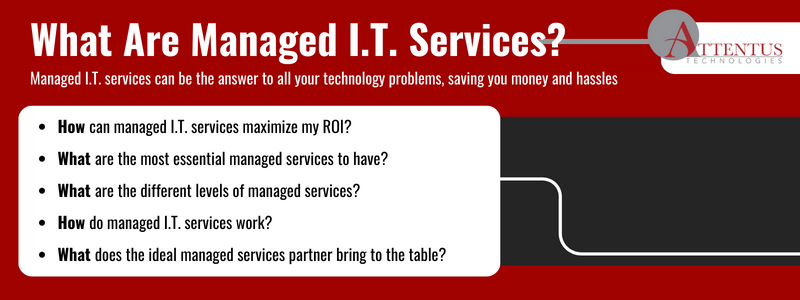Managed I.T. services can be the answer to all your technology problems, saving you money and hassles

Organizations increasingly depend on managed I.T. services to operate at peak efficiency and safety. The global managed services market was valued at $179.33 billion in 2021 and is expected to grow by $393.7 billion by 2028. About 60% of organizations are projected to depend on managed services by 2025, with some sectors, such as fintech, already deeply invested.
The point is, failing to leverage tools like the cloud or operating on a slow/unreliable network simply won’t cut it in a modern business environment. As a result, these deficiencies can allow your rivals to gain a competitive advantage, and they can open you up to cyberattacks.
Properly managed I.T. services can solve all your information technology problems.
The support involves a dependable, experienced third-party provider managing your entire I.T. environment. They are accountable for everything from ensuring your day-to-day operations aren’t disrupted by technology issues to proactively monitoring your network for cybersecurity threats to developing a long-term I.T. strategy.
Now, let’s dive deeper into what’s involved with managed I.T. services.
How Do Managed I.T. Services Work?
After connecting with the managed services provider that’s right for your business, you can select from various service and pricing models.
The benefits of having a qualified managing services provider include saving money, speeding up your response times, reducing risks, maintaining compliance, and others.
Statistics show “that successful deployment of managed services help reduce I.T. costs by 25 to 45% and will also increase the operational efficiency by 45 to -65%.
While there is a wide variety of managed I.T. services available, some of the most important ones include:
- Cloud services and support
- Managed security services
- Business continuity (disaster recovery, data backup)
- Network monitoring, support, updating, patching, and upgrading
- Technical support for all your I.T. assets (hardware, software, network)
- Mobile device support
- Technology procurement
- I.T. road-mapping and strategizing
- Compliance adherence
A highly qualified managed services provider (MSP) can ensure that all your I.T. needs are handled efficiently and continuously. They can also help with software training and support and, indeed, provide expert assistance for anything from broken computers to network design and configuration.
Ultimately, you have to ensure that your technology only helps your business grow—not hinder it. This is why it’s important to have the right managed services partner.
What Managed Services Do I Need?
Beware a support provider offering managed I.T. services without assessing your I.T. stack (the frontend and backend technologies comprising your work system). Otherwise, you may end up paying for extra services, eating away at your I.T.s budget for little to no ROI.
A strong MSP will offer a consultation and perform a comprehensive assessment of your I.T. stack before advising you on which services can benefit your business. The assessment could cover such important factors as:
- Server environment
- Infrastructure
- Security
- User devices
- Cloud setup
From there, you’ll have a better understanding of whether your business is best served by a:
- Break/fix model
- A la carte model
- Fully managed services model
Break/Fix Model
Typically, the most basic I.T. service package, a break/fix package, focuses solely on technical support. This means your business will have access to expert technicians and specialists who address I.T. issues as they occur, making the service reactive—provided only after problems arise.
While this allows your business to operate without major I.T. issues affecting productivity, it lacks proactive upgrades and enhancements that could improve your return on investment (ROI). These are typically offered by an MSP who is deeply familiar with your specific business needs.
Reactive services can also lead to more downtime, fixing issues that may crop up frequently because proactive measures weren’t taken.
This model is best suited for businesses with an in-house team that they want to supplement with elite, 24/7 on-call support. But for businesses interested in maximizing their I.T. ROI, the break/fix model leaves out many highly beneficial services, such as:
- Technology procurement support
- Network augmentation (making it faster and more resilient, able to handle higher workloads as you grow)
- Scaling support with long-term I.T. planning
- And more
With this model, you’ll typically pay per ticket for each I.T. issue addressed.
A la Carte
This is the second tier of managed I.T. services. It’s aimed at businesses needing various services but not ready for fully managed support. The model allows you to choose the services you need, ignoring those you don’t want.
This can be the most economically efficient model, but only in very specific circumstances. If you have a small in-house team or even a single I.T. person who can’t handle all the technological work required, a la carte services can fill in the work caps with targeted help. For example, if your team lacks in-depth cloud infrastructure knowledge, your managed I.T. partner can bring its extensive experience to bear to create a complete cloud solution.
That said, this service can be pricey. You’ll usually pay a reasonable flat monthly fee, but adding services as you go can quickly inflate costs. What’s more, you may be missing out on I.T. services that can make a huge difference to your business but are overlooked because of the selective nature of this model.
A la care costs depend on the types of services selected, the number of users, and the number and types of connected devices, among other factors.
Fully Managed I.T. Services
This is the top tier of services, providing the most comprehensive range of targeted I.T. help. Fully managed services enable you to get the most from your I.T. budget, serving to reduce costs while optimizing benefits.
By allowing a single provider to manage your entire technology stack, you maximize your ROI with synergistic solutions that address your full range of technology needs.
They can also help you save money and boost efficiency by identifying and eliminating redundancies and plugging holes in service gaps. You won’t be vulnerable if one of your I.T. people goes on vacation or sick leave. Your network will stay up and protected regardless of your internal employment situation.
You’ll also have a high-quality strategic partner whose value will be proven repeatedly.
Fully managed services are typically backed by a service level agreement (SLA) that guarantees quality results from your I.T. partner.
Benefits of outsourcing your I.T. infrastructure include:
- Cost savings
- Easy access to essential expertise
- Scalability and flexibility
- Enhanced cybersecurity
- More time to focus on core competencies
- Better compliance and risk management
Find the Perfect Technology Partner for Your Business
Looking for more than just a standard I.T. service provider? Look no further than Attentus. We’re here to establish a genuine partnership based on trust and collaboration. Contact Attentus for a free consultation and technology assessment.
With nearly two decades in the business, we have a remarkable customer satisfaction score (CSAT) of 97.5 You’ll soon see why clients appreciate working with us. At Attentus, we prioritize your growth and the seamless operation of your business.
Our service is fast, friendly, and comprehensive. You’ll soon find that we can successfully manage all your I.T. expectations.
